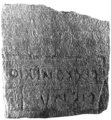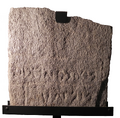VB·22 Stresa: Difference between revisions
No edit summary |
No edit summary |
||
| Line 2: | Line 2: | ||
|type_object=stela | |type_object=stela | ||
|material=stone | |material=stone | ||
|dimension=height | |dimension=height 48.5–59 cm, width 52–56.5 cm, thickness 4–6.5 cm | ||
|dimension_max= | |dimension_max=59 cm | ||
|condition=fragmentary | |condition=fragmentary | ||
|culture_archaeological=La Tène D | |autopsy=Corinna Salomon | ||
|sortdate=- | |date_autopsy=Apr 20 2024 | ||
|culture_archaeological=La Tène D 2 | |||
|sortdate=-40 | |||
|date=1<sup>st</sup> c. BC | |date=1<sup>st</sup> c. BC | ||
|date_derivation= | |date_derivation=typology, archaeological context | ||
|site=Stresa | |site=Stresa | ||
|field_name=Brisino | |field_name=Brisino | ||
| Line 20: | Line 22: | ||
|morandi=65 | |morandi=65 | ||
|source_detail=Morandi 2004: 563 f. no. 65 | |source_detail=Morandi 2004: 563 f. no. 65 | ||
|checklevel= | |checklevel=2 | ||
|problem= | |problem=original size/shape: Piana Agostinetti 2004, photo Poletti | ||
}} | }} | ||
==Commentary== | ==Commentary== | ||
Image in {{bib|De Giuli 1979}}: 246, fig. 1 (photo). | Image in {{bib|De Giuli 1979}}: 246, fig. 1 (photo). | ||
Fragment (upper part) of a mica schist stela, found together with [[VB·23 Stresa]], [[VB·24 Stresa]], [[VB·25 Stresa]]; see [[Brisino]] for the find circumstances and context. The original shape/size of the stone is unclear, but was clearly different from that of the stelae with Latin inscriptions from Brisino ([[VB·24 Stresa]], [[VB·25 Stresa]]) and both epichoric and Latin documents from [[Levo]]. {{bib|De Giuli 1979}}: 251 mentions the possibility that the Brisino stones may come from the same site as the finds in [[Levo]]. | Fragment (upper part) of a mica schist stela with slanting top edge, found in secondary context together with [[VB·23 Stresa]], [[VB·24 Stresa]], [[VB·25 Stresa]]; see [[Brisino]] for the find circumstances and context. The slab is somewhat thicker in the top corner than on the lower end. The original shape/size of the stone is unclear, but was clearly similar to that of [[VB·23 Stresa]] and different from that of the stelae with Latin inscriptions from Brisino ([[VB·24 Stresa]], [[VB·25 Stresa]]) and both epichoric and Latin documents from [[Levo]]. {{bib|De Giuli 1979}}: 251 mentions the possibility that the Brisino stones may come from the same site as the finds in [[Levo]], though it seems quite possible that a pre-Roman/Roman necropolis existed in Brisino in the area of the Chiesa di Sant'Albino. Among the Stresa gravestones, the present object and [[VB·23 Stresa]] have the most archaic shape and may thus represent the oldest layer, but {{bib|Mainardis 2009}}: 337 f. correctly points out that one stonemason/workshop would be able to produce stelae according to more traditional or modern tastes all dating to the same time. In any case, Morandi's dating to the late 2<sup>nd</sup> c. BC seems too early; the 1<sup>st</sup> c. BC is also given by {{bib|Tibiletti Bruno 1979}}: 254. See also '''{{bib|Caramella & De Giuli 1993}}: 207'''. | ||
{{bibliography}} | {{bibliography}} | ||
Revision as of 17:32, 9 May 2024
| Object | |
|---|---|
| Classification: | stela |
|
| |
| Material: | stone |
| Size: | height 48.5–59 cm, width 52–56.5 cm, thickness 4–6.5 cm |
| Condition: | fragmentary |
| Autopsy by: | Corinna Salomon |
| Date of autopsy: | Apr 20 2024 |
|
| |
| Archaeological culture: | La Tène D 2 |
| Date: | 1st c. BC |
| Date derived from: | typology, archaeological context |
|
| |
| Site: | Stresa (Verbano-Cusio-Ossola, Piemonte, Italy) |
| Field name: | Brisino |
| Archaeological context: | medieval tomb (Objects: VB·22 Stresa, VB·23 Stresa, VB·24 Stresa, VB·25 Stresa) |
| Coordinates (approx.): | 45° 52' 5.77" N, 8° 33' 33.42" E |
| Find date: | 1975 |
| Current location: | Museo Civico Antiquarium (Mergozzo) |
|
| |
| Inscription: | VB·22 (aśkonetio/pianu) |
|
| |
| Alternative sigla: | Tibiletti Bruno 1981: 14 Solinas 1995: 120 Morandi 2004: 65 |
|
| |
| Sources: | Morandi 2004: 563 f. no. 65 |
Images
Commentary
Image in De Giuli 1979: 246, fig. 1 (photo).
Fragment (upper part) of a mica schist stela with slanting top edge, found in secondary context together with VB·23 Stresa, VB·24 Stresa, VB·25 Stresa; see Brisino for the find circumstances and context. The slab is somewhat thicker in the top corner than on the lower end. The original shape/size of the stone is unclear, but was clearly similar to that of VB·23 Stresa and different from that of the stelae with Latin inscriptions from Brisino (VB·24 Stresa, VB·25 Stresa) and both epichoric and Latin documents from Levo. De Giuli 1979: 251 mentions the possibility that the Brisino stones may come from the same site as the finds in Levo, though it seems quite possible that a pre-Roman/Roman necropolis existed in Brisino in the area of the Chiesa di Sant'Albino. Among the Stresa gravestones, the present object and VB·23 Stresa have the most archaic shape and may thus represent the oldest layer, but Mainardis 2009: 337 f. correctly points out that one stonemason/workshop would be able to produce stelae according to more traditional or modern tastes all dating to the same time. In any case, Morandi's dating to the late 2nd c. BC seems too early; the 1st c. BC is also given by Tibiletti Bruno 1979: 254. See also Caramella & De Giuli 1993: 207.
Bibliography
| Caramella & De Giuli 1993 | Pierangelo Caramella, Alberto De Giuli, Archeologia dell'Alto Novarese, Mergozzo: Antiquarium Mergozzo 1993. |
|---|---|
| De Giuli 1978 | Alberto De Giuli, "Le stele funerarie di Brisino", Bollettino Storico per la Provincia di Novara 69/1 (1978), 13–20. |
| De Giuli 1979 | Alberto De Giuli, "Le stele funerarie di Brisino", Sibrium 14 (1978–1979), 245–252. |


